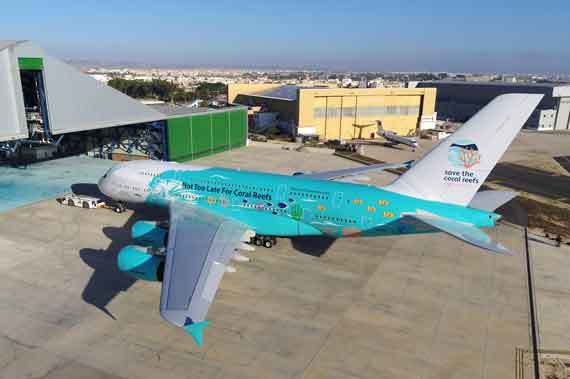More news
- Asian paint regulatory round up – Indonesian exterior paint still uses lead, warns W...
- Nigeria’s paint industry navigates regulatory changes and economic challenges amid p...
- Focus on the global coatings market: Global coatings market outlook
- Ask Joe Powder – October 2024
- Chinese paint majors look to domestic consumer sales as commercial real estate slumps

A global message to save the world’s coral reefs is being carried around the globe by an Airbus A380 specially coated by AkzoNobel.
The Mirpuri Foundation initiative involved painting a Hi Fly-owned aircraft with a striking livery depicting coral reefs.
One side represents a pristine ocean with healthy marine life, while the other shows a destroyed coral environment.
AkzoNobel created 19 colours for the design, many of which were custom-made, which helps drive home the message that our coral ecosystems will disappear by 2050 if no action is taken.
"We’re proud to be involved with the Mirpuri Foundation’s Save the Coral Reefs campaign, which aligns so well with our own ambitions to continue lowering our environmental impact," said Martijn Dieben, AkzoNobel Regional Sales Manager.
"The aircraft makes a strong statement about the importance of creating a sustainable future, and it’s good to see our products being used to carry such an important message."
AkzoNobel is a global leader in aerospace coatings, and the complex design showcases both the company’s colour expertise and technical know-how.
It also demonstrates an unrivalled ability to translate colour trends and new designs into relevant colour palettes.
"Our products and formulations provide fit-for-purpose lasting colour and protection," added Dieben.
"The very things that this campaign is focused on when it comes to fighting the destruction of coral reefs.
"Here’s hoping we can help to make a difference."
It’s the second time that AkzoNobel products have been used on a Mirpuri Foundation aircraft.
The company also supplied high performance aerospace coatings for the livery on their Turn the Tide on Plastic Airbus A330-200, which depicts a healthy ocean on one side and a polluted one on the other.



